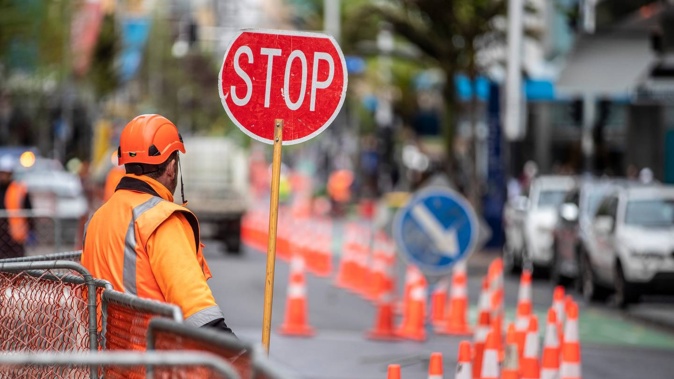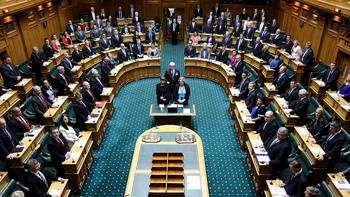
There’ll be a blitz on road maintenance this summer. But safety measures including lower speed limits around schools are at risk from the Auckland Council’s budget cuts and the new Government’s desire to overturn speed restrictions.
Auckland Transport will today launch a big new campaign to fix the region’s roads. It’s called the Summer Road Reno and will include 550km of road renewal and repairs. NZ Transport Agency Waka Kotahi will run a similar campaign nationwide.
“We want Aucklanders to know we’re out fixing the roads,” AT’s chief executive, Dean Kimpton, told Auckland Council’s transport and infrastructure committee yesterday.
His chief engineer, Murray Burt, said they’re also hoping people will respect the roadworkers. “They get a lot of abuse, sometimes. And we want everyone to drive safely when they encounter the work.”
There will be social media, posters, billboards and radio ads to support the programme.
Burt explained that the January floods damaged the roads at 2000 sites, mainly through slips and washouts.
Of those, 1200 were repaired in the first three months and a further 300 have been repaired since. There are still 500 more to fix.
Summer Road Reno is an attempt to get ahead of the potholes. “It costs $12-$16 per square metre for chipseal renewal and about $40sq m for asphalt. But if water gets in and we have to repair the road, the cost rises to $200-$400sq m.”
/cloudfront-ap-southeast-2.images.arcpublishing.com/nzme/IHY6FCP73VFM3MESLCPOBN7PQE.jpg) Poster for Auckland Transport's Summer Road Reno campaign.
Poster for Auckland Transport's Summer Road Reno campaign.
Maintenance has to be done in good weather. “But because Auckland has had so much rain this year,” Burt said, “it’s been very hard to keep up.”
However, they won’t be fixing everything. There is a gap of a little over $1 billion, nationwide over three years, between what councils want from NZTA for maintenance and repairs, and what they are getting at the moment. “It’s only about $350 million a year.”
The Herald asked the new Minister of Transport, Simeon Brown, if the Government will make up this shortfall.
He replied, “National campaigned on focusing our transport sector on building and maintaining our roading network. We have now started work on rewriting the Government policy statement on land transport so we can deliver on this commitment. This will help support NZTA and road controlling authorities across New Zealand to focus on fixing our roads, a top priority for this Government.”
/cloudfront-ap-southeast-2.images.arcpublishing.com/nzme/QSITAATW3BAXFORIMNEFZPFRP4.jpg) Transport Minister Simeon Brown with Prime Minister Christopher Luxon inspecting potholes during the election campaign. Photo / Alex Burton
Transport Minister Simeon Brown with Prime Minister Christopher Luxon inspecting potholes during the election campaign. Photo / Alex Burton
The council also heard from several presenters about threats to Auckland Transport’s draft speed management plan, called Katoa, Ka Ora. The name means “everyone alive, healthy and well”.
On Wednesday, AT’s head of safety, Stacey Van Der Putten, advised the council’s budget committee that proposed cuts to AT funding will “obviously” reduce its ability to lower the number of deaths and serious injuries on the roads.
“More people will potentially die or be seriously injured,” Van Der Putten said.
Yesterday, Students Against Dangerous Driving, the police, a pediatrician from Starship, a public health specialist and a road safety analyst all turned up to reinforce the message.
Orewa College student Rachel Slacke explained that she had grown up in a rural environment. “I cannot tell you the amount of times I have had to jump into a ditch walking my dogs, just to avoid being hit by a car.”
Two children are killed on our roads every week, she said, and 60 per cent of crashes involving children happen within 500 metres of their homes.
Ryan Antia from Mt Albert Grammar told the council, “You are adults, you are our guardians and yet you have failed to protect us, to speak up, to change the way we drive on our roads.”
/cloudfront-ap-southeast-2.images.arcpublishing.com/nzme/4STE4DUGVNFGLHPD6IB5VFETME.JPG)
Lower speeds in dangerous areas, including around schools, along with speed-reduction features such as raised tables and speed bumps, are identified in Mayor Wayne Brown’s draft 10-year budget as low-priority spending likely to be cut.
Geoff Upson disagreed with the students. He’s a member of the Rodney Local Board but he was appearing in a private capacity. Reducing speed limits doesn’t work, he said, because “there are still some fatal crashes on roads with lower speed limits”.
Councillor Chris Darby asked him, “How important is evidence to you?”
AT has reported that while deaths and serious injuries are rising on Auckland roads, they are falling on those roads with lower speed limits.
Councillor Ken Turner agreed with Upson. “We’re going to slow everybody down, for what gain?” he asked. “Why should everyone have to slow down because of the bad drivers?”
But Inspector Scott Webb had an answer. “Reduced speed will mean reduced deaths and serious injuries,” he said. “It’s a mindset thing for drivers. We all make mistakes, so if you’re not going so fast, you won’t do so much damage if you do crash.”
He supported the use of “traffic calming” measures “one hundred per cent”.
“Take Takapuna as an example. It used to be a racetrack, but the street design now makes people slow down and it has definitely worked.”
AT’s Kimpton had some good news. “There’s a new kind of road bump,” he said, “that can be prefabricated offsite and installed overnight.”
/cloudfront-ap-southeast-2.images.arcpublishing.com/nzme/BXNODACDRNCRRASPNMQO3TB75M.JPG)
It was suggested during the meeting that the new Government’s commitment to overturning existing speed reductions “where it is safe to do so” might make Katoa, Ka Ora redundant.
Councillors discussed this at length, and in some apparent confusion, before adjourning, then reconvening, and deciding they should not let the Government divert them from setting their own policy and programmes.
“Wellington should not tell Auckland what to do about Auckland,” is a common refrain from the mayor.
Councillor Turner suggested the question of speed in school zones should be dealt with separately from speed in other areas, but nobody took this up.
Councillor Christine Fletcher, who was chairing the meeting, told the Herald when it was over, “I feel very strongly about this. We need to have safety around schools. There are other issues around speed that are not so clear for everyone, but there’s a consensus around schools.”
But they did not vote only on schools. Despite the threats to funding and the potential for Government to intervene, the committee accepted a proposal by Councillor Julie Fairey to support the Katoa, Ka Ora in its entirety. That included its “principles, objectives and measures” and its “three-year implementation plan and 10-year vision”.
This contradicts the cuts proposed in the mayor’s draft 10-year budget. But although councillors have voted to send that budget to public consultation, they will not decide whether to adopt it until June next year.
It’s not clear if all the councillors realised they were endorsing the road-safety plan so enthusiastically.
Also at the meeting, members of Restore Passenger Rail staged a “sleep in”, wearing pyjamas and dressing gowns, to protest the way council has “fallen asleep” over its emissions targets. While most of them lay on the floor, with signs saying “Wake up! Climate crisis”, spokespeople read speeches and a story. Then they left.
/cloudfront-ap-southeast-2.images.arcpublishing.com/nzme/I4A6TLLVCBGPXFECOQXZPWF4TQ.jpg) Another poster for the Summer Road Reno campaign.
Another poster for the Summer Road Reno campaign.
Simon Wilson is an award-winning senior writer covering politics, the climate crisis, transport, housing, urban design and social issues, with a focus on Auckland. He joined the Herald in 2018.
Take your Radio, Podcasts and Music with you









